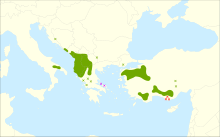Quercus trojana
| Macedonian oak | |
|---|---|
| Scientific classification | |
| Kingdom: | Plantae |
| Clade: | Angiosperms |
| Clade: | Eudicots |
| Clade: | Rosids |
| Order: | Fagales |
| Family: | Fagaceae |
| Genus: | Quercus |
| Subgenus: | Quercus subg. Quercus |
| Section: | Quercus sect. Cerris |
| Species: | Q. trojana |
| Binomial name | |
| Quercus trojana | |
 | |
| Distribution map | |
| Synonyms[2] | |
|
List
| |
Quercus trojana, the Macedonian oak is an oak in the 'turkey oak section' (Quercus sect. Cerris).
It is native to southeast Europe and southwest Asia, from southern Italy east across the southern Balkans to western Turkey, growing at low to moderate altitudes (up to 1550 m in the south of the range in southwestern Turkey), in dry areas.[3][4][5]
Description
Quercus trojana is a small to medium-sized tree reaching 10–20 m tall, late deciduous to semi-evergreen, with grey-green leaves 3–7 cm long and 1.5–4 cm broad with a coarsely serrated margin with sharply pointed teeth. The acorns are 2–4 cm long when mature about 18 months after pollination, and largely enclosed in the scaly acorn cup.[6]
Fossil record
Fossils of Quercus trojana have been described from the fossil flora of Kızılcahamam district in Turkey, which is of early Pliocene age.[7]
References
- ↑ "Quercus trojana Webb". Tropicos. Missouri Botanical Garden.
- ↑ "Quercus trojana Webb". World Checklist of Selected Plant Families (WCSP). Royal Botanic Gardens, Kew – via The Plant List.
- ↑ Christensen, Knud Ib. 1997. Flora Hellenica 1: 45
- ↑ Altervista Flora Italiana, Quercus trojana Webb
- ↑ Jerzy Zieliński, Ana Petrova and Dominik Tomaszewski 2006. Quercus trojana subsp. yaltirikii (Fagaceae), a New Subspecies from Southern Turkey. Willdenowia 36:845-849
- ↑ Webb, Philip Barker 1839.
- ↑ Kasaplıgil, B.-(1975): Pliocene Flora of Güvem village near Ankara, Turkey, Abstracts of the Papers Presented at the XII International Botanical Congress, Akademika Nauk SSSR, 1: 115, Leningrad
External links
- Quercus trojana - information, genetic conservation units and related resources. European Forest Genetic Resources Programme (EUFORGEN)